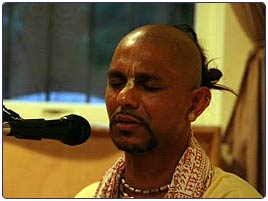Is Madhava the Voice of a New Generation?
By Vineet Chander (Vyenkata Bhatta Dasa) | Sep 04, 2008

Seeing a big tuft of matted dread-locks erupting from his otherwise shaven head, a sculpted goatee, and a host of piercings and tattoos, you expect Madhava Dasa to be more punk rocker than Hare Krishna chanter. Until, of course, he closes his eyes, opens his mouth, and begins to sing. Before he even finishes one complete mantra, well, he blows your mind. And by the time you are repeating the refrain, you are his—hook, line, and sinker. If you had any plans for the next few hours, go ahead and cancel them and make yourself an appointment with the holy names of Krishna instead.
Welcome to a Madhava kirtan.
A native of Mauritius, Madhava – nee Joy Naidoo – moved to Vrindavan at the age of 18. There, he spent every day of the next seven years participating in kirtan with the Krishna Balarama 24 Hour Kirtan Mandali, under the direction of legendary Hare Krishna chanter Aindra Dasa. Now married and living in Switzerland, Madhava leads an eclectic group of devotee musicians called the Gaura Prema Bhajan Band. Their Mantra Dance program, a multimedia kirtan experience, is held at the ISKCON temple on Sundays and in other locations by bookings.
Considering that he is known as much for his endurance – he will chant a single tune steadily for hours – as for a voice that has been favorably compared to silk, Madhava’s popularity is hardly surprising. What is noteworthy, however, is the speed and force with which his star is rising.
These days, if you find yourself in a kirtan-related conversation, count on Madhava’s name coming up more than once. Dissect the iPod of your favorite kirtan junkie, and chances are that you will bump into a few Madhava tracks high up on their playlist. Even Jayadvaita Swami, arguably ISKCON’s most vocal kirtan critic, has high praise for the young chanter. In fact, the Swami plays audio clips of Madhava to illustrate kirtan done right in his “Kirtan Reform” seminar—quite an endorsement, considering that the seminar offers far more don’ts than dos.
Of course, those in the know have sworn by Madhava for years now. Some of the biggest leaders in ISKCON (think Sivarama Swami, Niranjana Swami, Radhanath Swami, to name a few) have flown him in to lead the chanting at festivals they organized. However, it was most likely his chanting during the 2004 installation of the larger-than-life Pancha Tattva deities in Mayapur that was the tipping point that has since made Madhava an ISKCON household name.
Today, Madhava finds himself among a handful of young men and women – some of whom learned their first mridanga beats before they were eating solid foods – increasingly recognized as the torchbearers of a kirtan renaissance in ISKCON. Its a compelling argument. Combine a Hare Krishna upbringing with the passion and innovation of youth, and you have the recipe for the making of musical history.
Still, the more skeptical among us are adopting a wait and see attitude, fearing that behind the hype and technical skills, these kirtaniyas lack spiritual maturity and regulated practice of Krishna consciousness. Indeed, in some conservative circles, the perception that persists about the new school of kirtan is that its leaders are more rockstar than spiritualist, heavy on partying and light on principles.
Does Madhava’s rising popularity among the mainstream devotee demographic mean that ISKCON is finally ready to retire that stereotype? Perhaps. If you can get past the dreadlocks and tattoos, it is hard to deny that his chanting exudes a magic that only comes with sincerity, serious spiritual practice, and – dare we say – humility. It may be early to lock it in, but if the adage about knowing the merits of a tree by its fruit is to be trusted, in Madhava’s kirtans Generation Next may have found its finest answer to its harshest critics.














